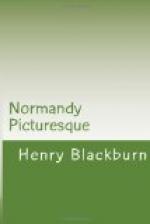There are few monuments or churches to examine, and when we have seen the stained-glass windows in the fine old church of St. Ouen, and walked by the banks of the Rille, to the ruins of a castle (of the twelfth century) at Montfort; we shall have seen the chief objects of interest, in what Murray laconically describes as, ’a prettily situated town of 5400 inhabitants, famed for its tanneries.’
Early morning at Pont Audemer.
That there is ‘nothing new under the sun,’ may perhaps be true of its rising; nevertheless, a new sensation awaits most of us, if we choose to see it under various phases. The early morning at Pont Audemer is the same early morning that breaks upon the unconscious inhabitants of a London street; but the conditions are more delightful and very much more picturesque; and we might be excused for presenting the picture on the simple ground that it treats of certain hours of of the twenty-four, of which most of us know nothing, and in which (such are the exigencies of modern civilization) most of us do nothing.
[Illustration: OLD HOUSES, PONT AUDEMER.]
A storm passed over the town one night in August, which shook the great rafters of the old houses, and made the timbers strain; the water flowed from them as from the sides of a ship—one minute they were illuminated, the next, they were in blackest gloom. In two or three hours it has all passed away, and as we go out into the silent town, and cross the street where it forms a bridge over the Rille (the spot from which the next sketch was taken), a faint gleam of light appears upon the water, and upon the wet beams of one or two projecting gables. The darkness and the ‘dead’ silence are soon to be disturbed—one or two birds fly out from the black eaves, a rat crosses the street, some distant chimes come upon the wind, and a faint clatter of sabots on the wet stones; the town clock strikes half-past three, and the watchman puts out his lantern, and goes to sleep. The morning is breaking on Pont Audemer, and it is the time for surprises—for the sudden appearance of a gable-end, which just now was shadow, for the more gradual, but not less curious, formation of a street in what seemed to be space; for the sudden creation of windows in dead walls, for the turning of fantastic shadows into palpable carts, baskets, piles of wood, and the like; and for the discovery of a number of coiled-up dogs (and one or two coiled-up men) who had weathered the night in sheltered places.
But the grey light is turning fast to gold, the warmer tints begin to prevail, the streets leading eastward are gleaming, and the hills are glistening in their bright fresh green.[9] The sweet morning air welcomes us as we leave the streets and its five thousand sleepers, and pass over another bridge and out by the banks of the Rille, where the fish are stirring in the swollen stream, and the lilies are dancing on the water. The wind blows freshly through the trees, and scatters the raindrops thickly; the clouds, the last remnant of the night’s storm, career through a pale blue space, the birds are everywhere on the wing, cattle make their appearance in the landscape, and peasants are already to be seen on the roads leading to the town.




